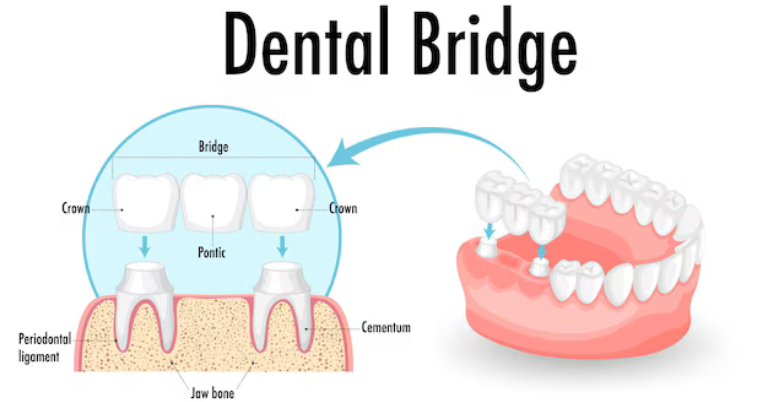Missing teeth can significantly impact both your oral health and confidence. One effective solution to restore your smile and improve your bite is a dental bridge. In this comprehensive guide, we’ll cover everything you need to know about dental bridges, including their types, benefits, and costs.
What Are Dental Bridges?
A dental bridge is a prosthetic device used to replace one or more missing teeth. It literally “bridges” the gap created by missing teeth using artificial teeth, known as pontics, that are anchored in place by adjacent natural teeth or implants. Dental bridges are a popular option for restoring both the function and appearance of your smile.
Types of Dental Bridges
There are several types of dental bridges, each suited to different needs. Here are the four main types:
1. Traditional Dental Bridge
The traditional dental bridge is the most common type. It involves creating a crown for the teeth on either side of the gap (called abutment teeth) and placing a false tooth (pontic) in between. This type is ideal for patients with natural teeth on both sides of the missing tooth.
Pros:
- Strong and durable
- Suitable for replacing multiple missing teeth
Cons:
- Requires the removal of enamel from adjacent teeth
2. Cantilever Dental Bridge
A cantilever bridge is similar to a traditional bridge but is anchored on only one side. It is used when there is only one natural tooth next to the gap.
Pros:
- Requires fewer crowns
- Useful in cases with limited teeth for support
Cons:
- Less stable than traditional bridges
- Not recommended for areas that endure significant chewing force
3. Implant-Supported Bridge
This type of bridge is supported by dental implants rather than natural teeth. Implant-supported bridges are ideal for patients missing several teeth in a row.
Pros:
- Extremely durable and long-lasting
- Does not require support from natural teeth
Cons:
- More expensive
- Requires surgery and a longer healing period
Benefits of Dental Bridges
Dental bridges offer several benefits beyond simply improving your smile. Here are some of the key advantages:
1. Restores Your Smile
Missing teeth can affect your appearance and confidence. A dental bridge can fill the gap, giving you a complete, natural-looking smile.
2. Improves Chewing and Speaking Abilities
Missing teeth can make it difficult to chew food properly and may impact your speech. Dental bridges help restore these functions, allowing you to eat and speak comfortably.
3. Maintains Facial Structure
Teeth play a crucial role in supporting your facial structure. Missing teeth can cause your face to appear sunken or aged. Dental bridges help maintain your facial shape by preventing bone loss in the jaw.
4. Prevents Teeth from Shifting
When a tooth is missing, the adjacent teeth may shift into the empty space, leading to alignment issues and bite problems. A dental bridge keeps your teeth in place and prevents further dental complications.
5. Enhances Oral Health
Replacing missing teeth with a bridge helps distribute the biting force evenly across your teeth, reducing the risk of oral health issues like gum disease and further tooth loss.
The Procedure for Getting a Dental Bridge
The process of getting a dental bridge typically involves two to three visits to the dentist.
1. Consultation and Examination
Your dentist will examine your oral health and take X-rays to determine if you’re a suitable candidate for a dental bridge. They will also discuss the different types of bridges available and recommend the best option for you.
2. Preparation
If you’re getting a traditional or cantilever bridge, the abutment teeth need to be prepared. This involves reshaping the adjacent teeth to accommodate the crowns. Impressions are then taken to create a custom bridge that fits perfectly.
3. Temporary Bridge Placement
While your permanent bridge is being made, your dentist will place a temporary bridge to protect the exposed teeth and gums.
4. Permanent Bridge Placement
Once your permanent bridge is ready, your dentist will remove the temporary bridge and cement the new one in place. Adjustments may be made to ensure a comfortable fit.
Maintaining Your Dental Bridge
To ensure the longevity of your dental bridge, proper care is essential. Here are some maintenance tips:
1. Practice Good Oral Hygiene
Brush twice a day and floss daily to keep your teeth and gums healthy. Special flossing tools can help clean under the bridge.
2. Avoid Hard Foods
Avoid chewing on hard foods like ice, nuts, or hard candies, as they can damage your bridge.
3. Regular Dental Checkups
Visit your dentist regularly for checkups and professional cleanings to maintain your oral health and ensure your bridge remains in good condition.
Conclusion
Dental bridges are an excellent solution for replacing missing teeth and restoring your smile. With various types available, you can find a bridge that suits your needs and budget. By understanding the types, benefits, and costs, you can make an informed decision and improve your oral health and quality of life. Always consult with your dentist to determine the best dental bridge option for you.

